Wi-Fi Sensing and Passenger Counting: A Statistical Analysis of Local Factors and Error Patterns
Abstract
1. Introduction
2. Materials and Methods
2.1. Experimental Protocol for Data Collection
The Identification of Local Factors
- Centre (1): the centre is characterised by high commercial and moderate residential building density, accompanied by very high pedestrian traffic.
- Urban (2): urban areas have moderate commercial and high residential building density, with moderate pedestrian traffic.
- Suburban (3): suburban areas feature low commercial and moderate residential building density, along with moderate pedestrian traffic.
- Extra-urban (4): extra-urban areas have low commercial and residential building density, with low pedestrian traffic.
- TS1—00:00 AM to 06:59 AM;
- TS2—07:00 AM to 08:59 AM;
- TS3—09:00 AM to 10:59 AM;
- TS4—11:00 AM to 12:59 AM;
- TS5—01:00 PM to 02:59 PM;
- TS6—03:00 PM to 04:59 PM;
- TS7—05:00 PM to 06:59 PM;
- TS8—07:00 PM to 11:59 PM.
2.2. Accuracy Calculation
- It is an error expressed as a percentage.
- It has a clear upper and lower bound, and with the specific version of SMAPE used, the bounds are 100% and 0%, respectively.
- At is the actual value—in this case, manual count values at each stop;
- Ft is the forecast value or estimate—in this case, the estimate by the APC system.
- SMAPE is the error calculated from Equation (1).
- Oc is the vehicle load that can be compared with the APC estimated count;
- TPPR is the Totale_pass_porte_richiuse (number of passengers inside the bus when the doors close) as reported by the manual counters.
- Delta (∂) is the difference between apc_count and the occupancy count;
- apc_count is the average of the apc_count values between stops;
- Oc is the vehicle load (Equation (3))
2.3. Multilevel Modelling
- Negligible differences (Pattern 1): vehicle trips with all ∂ values between −5 and +5;
- Significant differences (Pattern 2): vehicle trips not belonging to the Pattern 1 sub-group and where all ∂ values are between −10 and +10;
- Significant and predominantly positive differences (Pattern 3): vehicle trips with a minimum ∂ value greater than −10 and a maximum ∂ value greater than +10;
- Significant and predominantly negative differences (Pattern 4): vehicle trips with a minimum ∂ value less than −10 and a maximum ∂ value less than +10.
3. Results
3.1. Data Collected Through the Experimental Protocol
3.2. APC Accuracy
3.3. Statistical Analysis and Multilevel Modelling
Outliers in Data
4. Discussion
5. Conclusions and Way Forward
Author Contributions
Funding
Institutional Review Board Statement
Informed Consent Statement
Data Availability Statement
Acknowledgments
Conflicts of Interest
References
- Xu, Z.; Chopra, S.S.; Lee, H. Resilient Urban Public Transportation Infrastructure: A Comparison of Five Flow-Weighted Metro Networks in Terms of the Resilience Cycle Framework. IEEE Trans. Intell. Transp. Syst. 2021, 23, 12688–12699. [Google Scholar] [CrossRef]
- Mccarthy, C.; Moser, I.; Jayaraman, P.P.; Ghaderi, H.; Tan, A.M.; Yavari, A.; Mehmood, U.; Simmons, M.; Weizman, Y.; Georgakopoulos, D.; et al. A Field Study of Internet of Things-Based Solutions for Automatic Passenger Counting. IEEE Open J. Intell. Transp. Syst. 2021, 2, 384–401. [Google Scholar] [CrossRef]
- Leviakangas, P. Digitalisation of Finland’s transport sector. Technol. Soc. 2016, 47, 1–15. [Google Scholar] [CrossRef]
- Fihn, J.; Finndahl, J. A Framework for How to Make Use of an Automatic Passenger Counting System. 2011. Independent Thesis Advanced Level. Available online: https://urn.kb.se/resolve?urn=urn:nbn:se:uu:diva-158139 (accessed on 3 December 2024).
- Gerland, H.E.; Sutter, K. Automatic Passenger Counting (APC): Infra-Red Motion Analyzer for accurate counts in stations and rail, light-rail and bus operations. In Proceedings of the 1999 APTA Bus Conference; American Public Transportation Association: Washington, DC, USA, 2013. [Google Scholar]
- Vieira, D.F.; Júnior, H.G. Public Transportation Passengers Accounting at University by IoT Device. In Proceedings of the 2022 Symposium on Internet of Things (SIoT), Sao Paulo, Brazil, 24–28 October 2022. [Google Scholar] [CrossRef]
- Hepner, E.; Zhao, C.; Seipel, K.; Hoyer, R. Optimisation of the traffic flow in public transport through C-ITS. In Proceedings of the 7th International Conference on Models and Technologies for Intelligent Transportation Systems (MT-ITS), Heraklion, Greece, 16–17 June 2021; pp. 1–5. [Google Scholar] [CrossRef]
- Zhou, C.; Dai, P.; Wang, F.; Zhang, Z. Predicting the passenger demand on bus services for mobile users. Pervasive Mob. Comput. 2016, 25, 48–66. [Google Scholar] [CrossRef]
- Cisco. Cisco Annual Internet Report (2018–2023) White Paper; Cisco: San Jose, CA, USA, 2020; Volume 10, pp. 1–35. Available online: https://www.cisco.com/c/en/us/solutions/collateral/executive-perspectives/annual-internet-report/white-paper-c11-741490.html (accessed on 22 November 2024).
- Statista. Number of Smartphone Subscriptions Worldwide from 2016 to 2027. Available online: https://www.statista.com/statistics/330695/number-of-smartphone-users-worldwide/ (accessed on 15 November 2024).
- Abedi, N.; Bhaskar, A.; Chung, E. Bluetooth and Wi-Fi MAC address based crowd collection and monitoring: Benefits, challenges and enhancement. In Proceedings of the Australasian Transport Research Forum 2013, Brisbane, Australia, 2–4 October 2013; pp. 1–17. [Google Scholar]
- Hidayat, A.; Terabe, S.; Yaginuma, H. WiFi Scanner Technologies for Obtaining Travel Data about Circulator Bus Passengers: Case Study in Obuse, Nagano Prefecture, Japan. Transp. Res. Rec. 2018, 2672, 45–54. [Google Scholar] [CrossRef]
- Schauer, L.; Werner, M.; Marcus, P. Estimating crowd densities and pedestrian flows using Wi-Fi and bluetooth. In Proceedings of the 11th International Conference on Mobile and Ubiquitous Systems: Computing, Networking and Services, London, UK, 2–5 December 2014; pp. 171–177. [Google Scholar] [CrossRef]
- Oransirikul, T.; Nishide, R.; Piumarta, I.; Takada, H. Measuring Bus Passenger Load by Monitoring Wi-Fi Transmissions from Mobile Devices. Procedia Technol. 2014, 18, 120–125. [Google Scholar] [CrossRef]
- Mikkelsen, L.; Buchakchiev, R.; Madsen, T.; Schwefel, H.P. Public transport occupancy estimation using WLAN probing. In Proceedings of the 8th International Workshop on Resilient Networks Design and Modeling, RNDM, Halmstad, Sweden, 13–15 September 2016; Institute of Electrical and Electronics Engineers Inc.: Piscataway, NJ, USA, 2016; pp. 302–308. [Google Scholar] [CrossRef]
- Reichl, P.; Oh, B.; Ravitharan, R.; Stafford, M. Using Wifi Technologies to Count Passengers in Real-time around Rail Infrastructure. In Proceedings of the 2018 International Conference on Intelligent Rail Transportation (ICIRT), Singapore, 12–14 December 2018; pp. 1–5. [Google Scholar] [CrossRef]
- Fenske, E.; Brown, D.; Martin, J.; Mayberry, T.; Ryan, P.; Rye, E. Three Years Later: A Study of MAC Address Randomization in Mobile Devices and When It Succeeds. Proc. Priv. Enhancing Technol. 2021, 164–181. [Google Scholar] [CrossRef]
- Nitti, M.; Pinna, F.; Pintor, L.; Pilloni, V.; Barabino, B. Iabacus: A Wi-Fi-based automatic bus passenger counting system. Energies 2020, 13, 1446. [Google Scholar] [CrossRef]
- APPLE Inc. Wi-Fi Privacy. Apple Support. 2021. Available online: https://support.apple.com/guide/security/wi-fi-privacy-secb9cb3140c/web (accessed on 19 August 2022).
- Choi, H.; Fujimoto, M.; Matsui, T.; Misaki, S.; Yasumoto, K. Wi-CaL: WiFi Sensing and Machine Learning Based Device-Free Crowd Counting and Localization. IEEE Access 2022, 10, 24395–24410. [Google Scholar] [CrossRef]
- Aesys. Video Surveillance System, CCTV and Passenger Counting. 2023. Available online: https://www.aesys.com/products-solutions/bus/on-board-systems/video-surveillance-system-cctv-and-passenger-counting.html (accessed on 19 August 2022).
- Dilax. Automatic Passenger Counting (APC): Sensors & Systems. 2023. Available online: https://www.dilax.com/en/products/automatic-passenger-counting (accessed on 15 November 2024).
- Eurotech. DynaPCN 10-20|Automatic Passenger Counter Ethernet or PoE. 2021. Available online: http://www.eurotech.com/en/products/intelligent-sensors/people-counters/dynapcn-10-20 (accessed on 15 November 2024).
- Eurotech. PCN-1001—Automatic Passenger Counter—RS-485 Interface. 2023. Available online: https://www.eurotech.com/attachment/datasheet?id=69&format=A4 (accessed on 15 November 2024).
- Xovis. People Sensing. Available online: https://www.xovis.com/technology/sensor/ (accessed on 10 April 2025).
- Iris Sensing. IRMA 6: A New Generation of Automatic Passenger Counting. Iris Intell. Sens. 2023. Available online: https://www.iris-sensing.com/us/products/irma-6/ (accessed on 10 April 2023).
- Pronello, C.; Garzón Ruiz, X.R. Evaluating the Performance of Video-Based Automated Passenger Counting Systems in Real-World Conditions: A Comparative Study. Sensors 2023, 23, 7719. [Google Scholar] [CrossRef] [PubMed]
- World Bank Blogs. How Do We Define Cities, Towns, and Rural Areas? Available online: https://blogs.worldbank.org/sustainablecities/how-do-we-define-cities-towns-and-rural-areas (accessed on 15 November 2024).
- Pew Res. Center’s Soc. Demogr. Trends Proj. What Unites and Divides Urban, Suburban and Rural Communities. Available online: https://www.pewresearch.org/social-trends/2018/05/22/what-unites-and-divides-urban-suburban-and-rural-communities/ (accessed on 10 January 2023).
- Google Maps. Plan Your Commute or Trip—Android—Google Maps Help—Typical Traffic. Available online: https://support.google.com/maps/answer/7565193?hl=en&co=GENIE.Platform%3DAndroid&sjid=12792780725296773485-EU&oco=0 (accessed on 10 January 2021).
- Flores, B.E. A pragmatic view of accuracy measurement in forecasting. Omega 1986, 14, 93–98. [Google Scholar] [CrossRef]
- Towardsdatascience. Choosing the Correct Error Metric: MAPE vs. sMAPE. Available online: https://towardsdatascience.com/choosing-the-correct-error-metric-mape-vs-smape-5328dec53fac (accessed on 15 November 2024).
- Buxton, R. Statistics: Multilevel modelling. In Mathematics Learning Support Centre-Technical Report; Taylor Francis: Abingdon, UK, 2008. [Google Scholar]
- Lara, J.D.; Guerra, E.; Cuadrado, J.S. When and How to Use Multilevel Modelling. ACM Trans. Softw. Eng. Methodol. 2014, 24, 1–46. [Google Scholar] [CrossRef]
- Ibrahim, O.T.; Gomaa, W.; Youssef, M. CrossCount: A Deep Learning System for Device-Free Human Counting Using WiFi. IEEE Sens. J. 2019, 19, 9921–9928. [Google Scholar] [CrossRef]
- Liu, S.; Zhao, Y.; Xue, F.; Chen, B.; Chen, X. DeepCount: Crowd Counting with WiFi via Deep Learning. arXiv 2019, arXiv:1903.05316. [Google Scholar] [CrossRef]
- Dong, Q.; Dargie, W. Evaluation of the Reliability of RSSI for Indoor Localization. In Proceedings of the International Conference on Wireless Communications in Underground and Confined Areas, Clermont-Ferrand, France, 28–30 August 2012; pp. 1–6. [Google Scholar] [CrossRef]
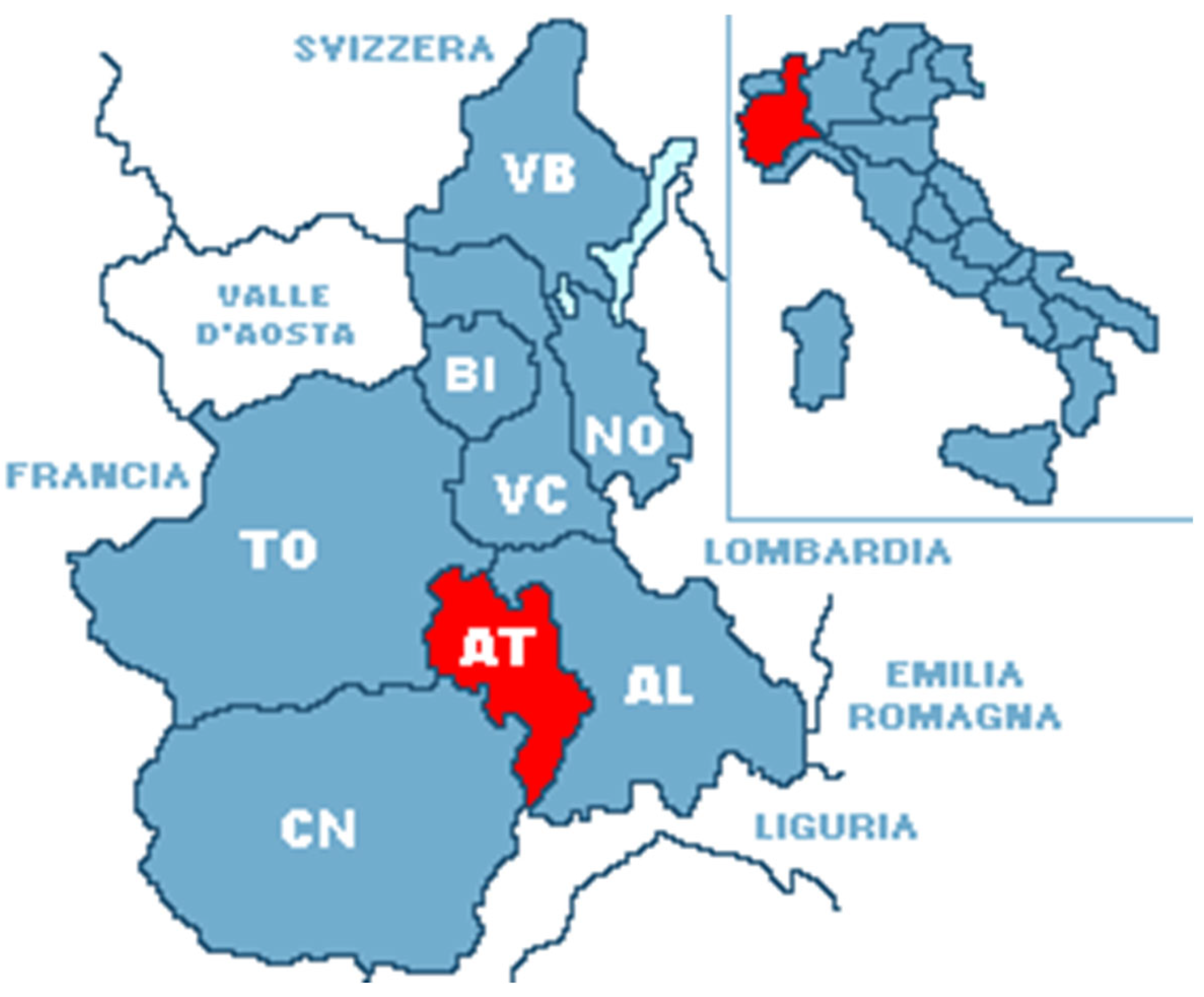

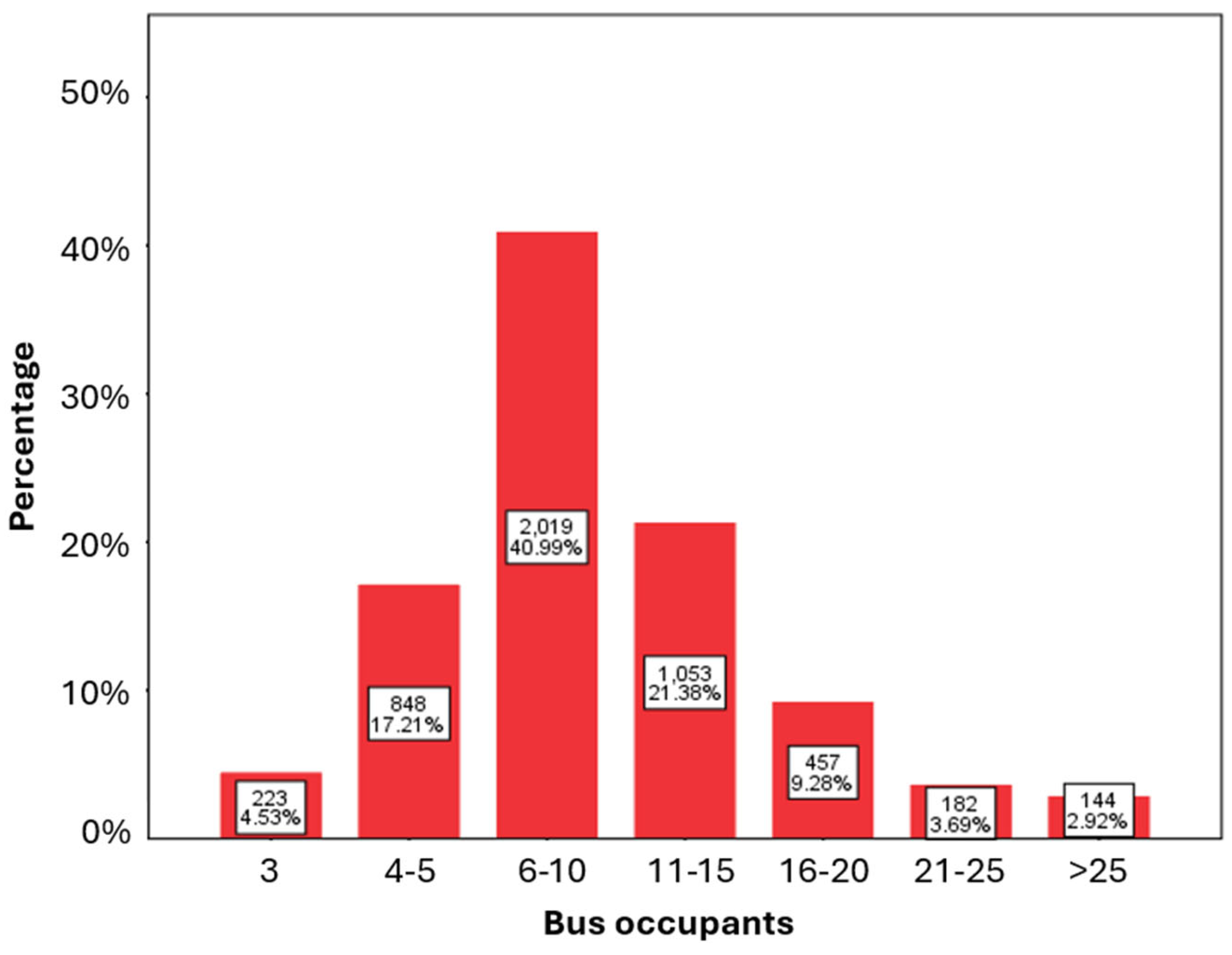
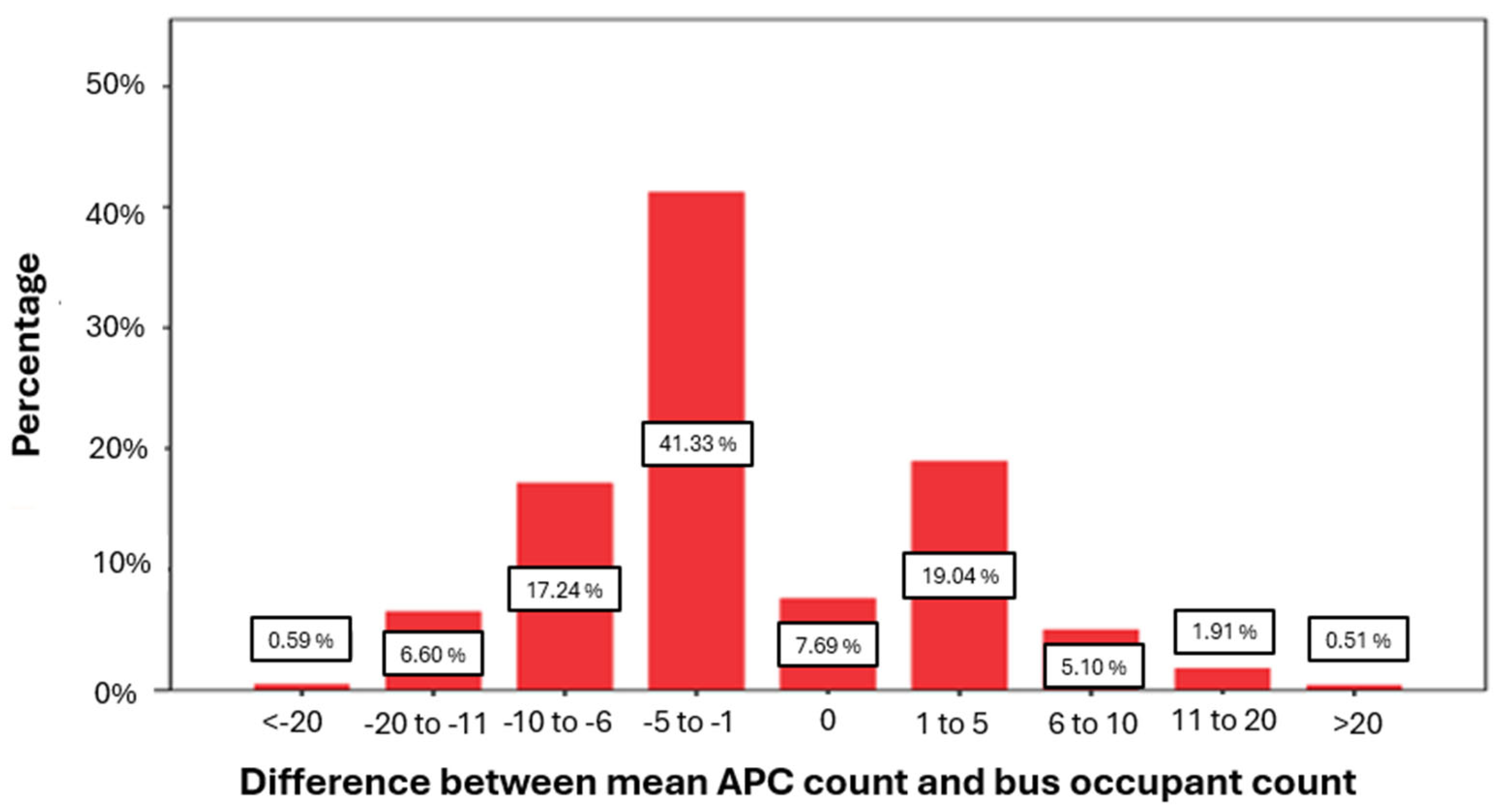

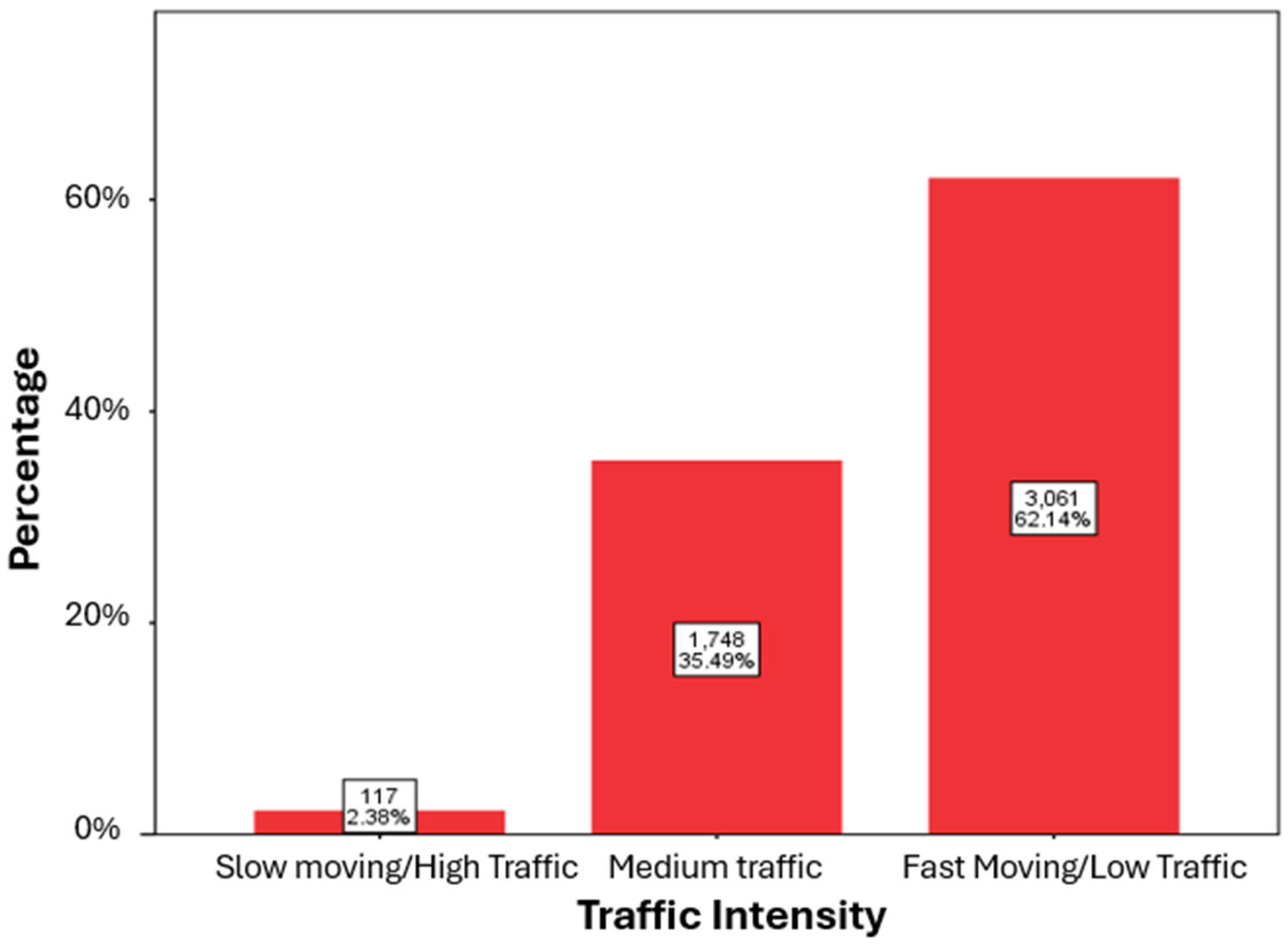
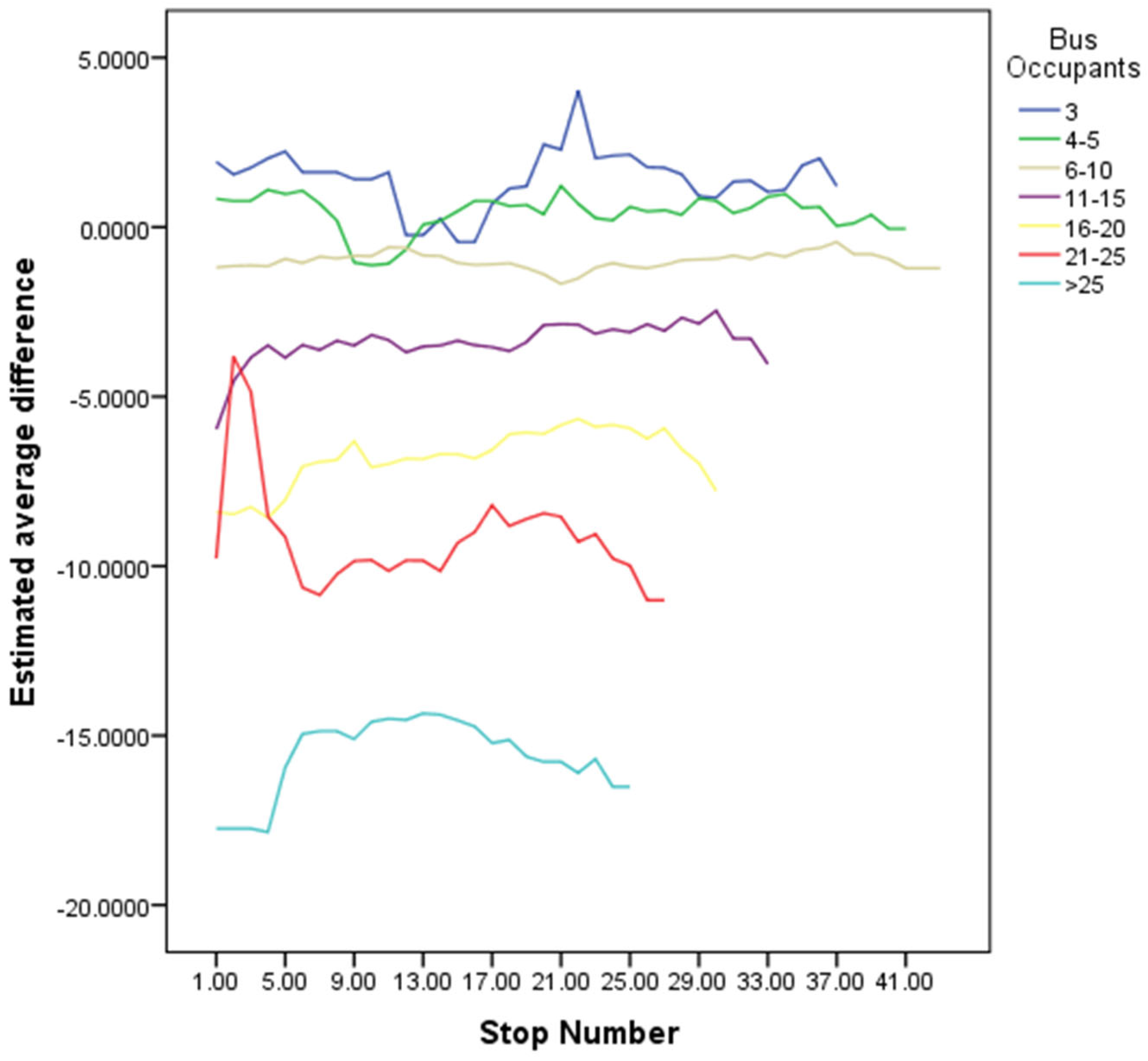
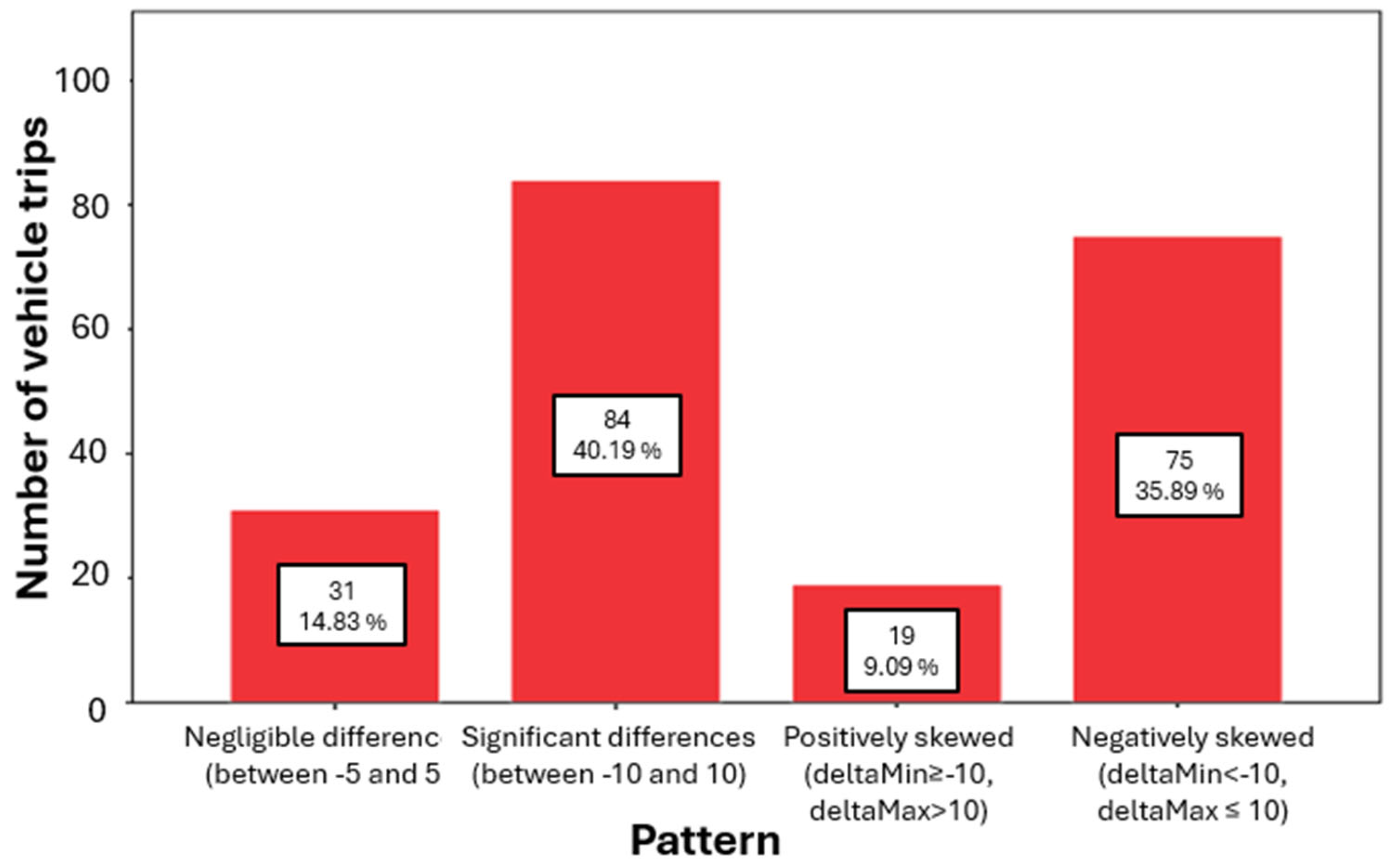

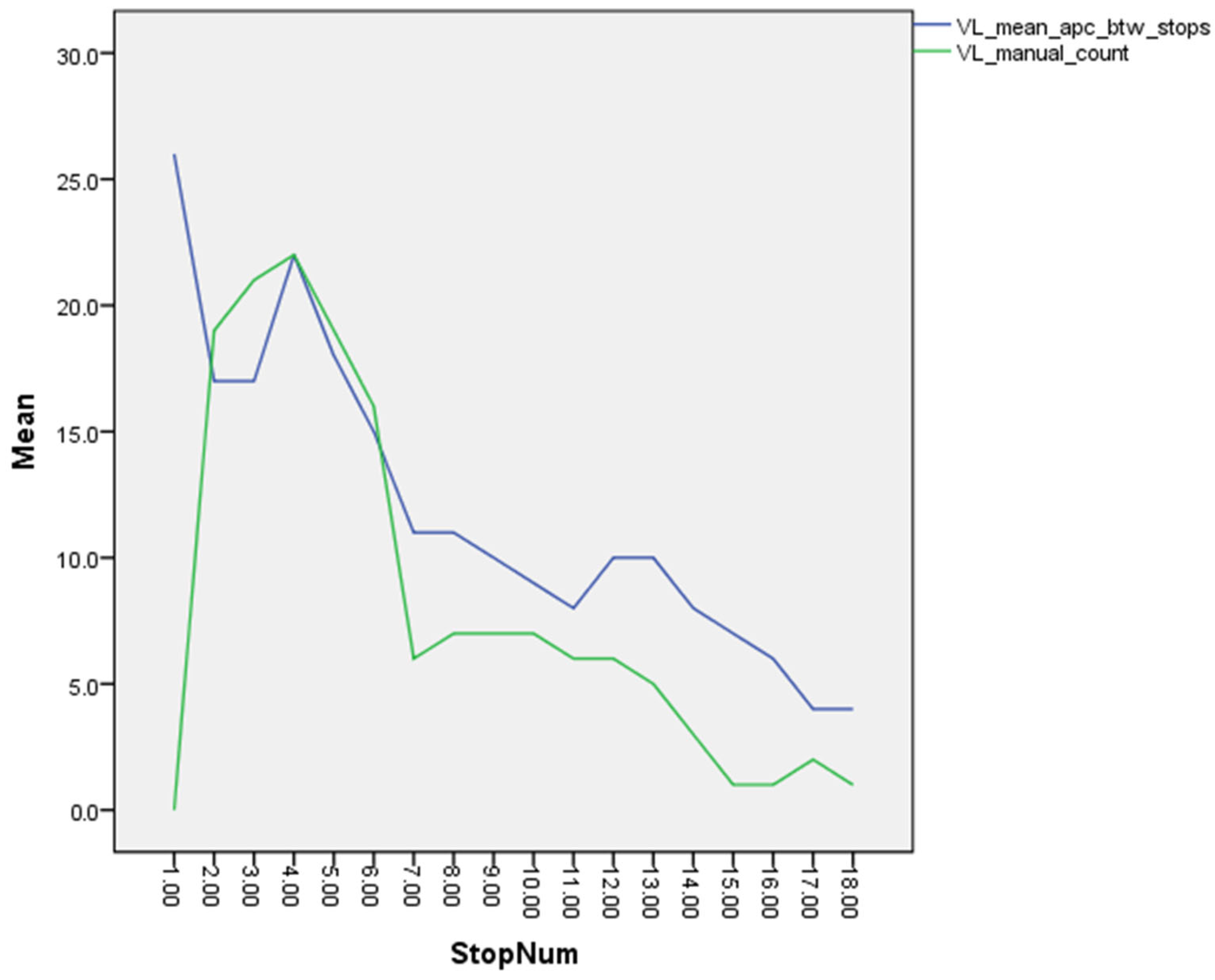
| Data Source | Field Name | Field Description |
|---|---|---|
| MFA’s APC system | timestamp_dt | Date and time of data collection as reported by the APC system |
| MFA’s APC system | vehicle_or_asset_ID | ID of the vehicle—unique to each vehicle (our data features only one vehicle). |
| MFA’s APC system | apc_count | Vehicle load (i.e., number of passengers) on the bus at the time calculated by MFA’s APC system. Average of multiple reported values between stops. Also referred to as avg_apc_count or mean_apc_count. |
| MFA’s APC system | coordinates | Location of the vehicle with longitude and latitude. |
| Manual count exercise | timestamp_dt_mc | Date and time of data collection as reported by manual counters. |
| Manual count exercise | Linea | Line on which the bus was running. |
| Manual count exercise | Corsa | Trip ID on that day for that bus and that crew. Used in combination with Linea and date information to uniquely identify a trip. |
| Manual count exercise | ID_Fermata | Unique bus stop ID code—the last stop at which the bus stopped. |
| Manual count exercise | stop_name | Extended name of the bus stop—the last stop at which the bus stopped. |
| Manual count exercise | Numero fermata | Sequence number of a stop for the specific Linea (line) and Corsa (ride). |
| Manual count exercise | Fermata effettuata | Did the bus stop at this specific stop? 1 = Yes; 0 = No (as reported by manual counters). |
| Manual count exercise | Totale_pass_porte_richiuse | Vehicle load as reported by manual counters—considered as ground truth. |
| Manual count exercise | Boarding_manual | Number of passengers who boarded bus at the previous stop (as per manual counters). |
| Manual count exercise | Alighting_manual | Number of passengers who alighted from the bus at the previous stop (as per manual counters). |
| Stop id | Stop Name | Stop Cat | Traffic ts1 (0–6) | Traffic ts2 (7–8) | Traffic ts3 (9–10) | Traffic ts4 (11–12) | Traffic ts5 (13–14) | Traffic ts6 (15–16) | Traffic ts7 (17–18) | Traffic ts8 (19–23) |
|---|---|---|---|---|---|---|---|---|---|---|
| 1 | San Marzanotto Piana-278 | 4 | 3 | 3 | 3 | 3 | 3 | 3 | 3 | 3 |
| 2 | San Marzanotto-276 | 4 | 3 | 3 | 3 | 3 | 3 | 3 | 3 | 3 |
| 3 | San Marzanotto-Strada Boccanera | 4 | 3 | 3 | 3 | 3 | 3 | 3 | 3 | 3 |
| 4 | Strada Provinciale-Rocca Schiavina | 4 | 3 | 2 | 3 | 3 | 3 | 3 | 2 | 3 |
| 5 | Corso Savona-Boana | 4 | 3 | 2 | 3 | 3 | 3 | 3 | 2 | 3 |
| 6 | Corso Savona 461-Muraneira | 4 | 3 | 2 | 3 | 3 | 3 | 3 | 2 | 3 |
| 7 | Corso Savona-Ponte Tànaro | 4 | 3 | 2 | 3 | 3 | 3 | 3 | 2 | 3 |
| 8 | Corso Savona-Via Pio | 3 | 3 | 2 | 3 | 2 | 2 | 2 | 2 | 3 |
| 9 | Corso Savona-Via Cirio | 3 | 3 | 2 | 3 | 2 | 2 | 2 | 2 | 3 |
| 10 | Corso Savona-80 | 2 | 3 | 3 | 3 | 2 | 2 | 2 | 2 | 2 |
| Accuracy % | No. of Records | |
|---|---|---|
| Monday | 64.55% | 1023 |
| Tuesday | 65.65% | 1044 |
| Wednesday | 65.50% | 1164 |
| Thursday | 69.45% | 1077 |
| Friday | 62.90% | 618 |
| Overall | 65.87% | 4926 |
| Number of People in the Bus | Estimated Averages of Delta (95% CI) |
|---|---|
| 3 | 1.25 (0.54; 1.95) |
| 4–5 | 0.40 (−0.08; 0.89) |
| 6–10 | −1.17 (−1.61; −0.73) |
| 11–15 | −3.38 (−3.87; −2.90) |
| 16–20 | −6.10 (−6.67; −5.52) |
| 21–25 | −9.32 (−10.07; −8.57) |
| >25 | −14.83 (−15.82; −13.84) |
| Pattern 1: Negligible Differences | Pattern 2: Significant Differences | Pattern 3: Significant and Predominantly Positive Differences | Pattern 4: Significant and Predominantly Negative Differences | |
|---|---|---|---|---|
| Number of People in the Bus | Estimated Averages (95% CI) | |||
| 3 | 0.83 (0.03; 1.62) | 1.34 (0.583; 2.10) | 6.89 (3.16; 10.62) | −0.27 (−1.57; 1.04) |
| 4–5 | −0.11 (−0.54; 0.32) | 0.15 (−0.36; 0.65) | 6.05 (3.32; 8.78) | −0.45 (−1.26; 0.37) |
| 6–10 | −1.36 (−1.77; −0.95) | −1.49 (−1.93; −1.05) | 5.20 (2.66; 7.73) | −2.35 (−3.03; −1.67) |
| 11–15 | −2.82 (−3.64; −2.01) | −3.68 (−4.20; −3.18) | 4.11 (1.40; 6.83) | −5.02 (−5.72; −4.31) |
| 16–20 | −6.05 (−8.60; −3.50) | −5.99 (−6.72; −5.25) | 1.68 (−1.67; −5.02) | −7.77 (−8.54; −7.00) |
| 21–25 | --- | −7.82 (−9.34; −6.30) | −1.70 (−5.57; 2.20) | −11.18 (−12.11; 10.24) |
| >25 | --- | −6.79 (−10.02; −3.57) * | −6.17 (−10.48; −1.85) * | −17.07 (−18.27; −15.87) |
| Number of People in the Bus | Estimated Averages (95% CI) |
|---|---|
| 3 | 0.78 (0.14; 1.41) |
| 4–5 | 0.03 (−0.38; 0.44) |
| 6–10 | −1.58 (−1.94; −1.21) |
| 11–15 | −3.84 (−4.25; −3.43) |
| 16–20 | −6.43 (−6.92; −5.92) |
| 21–25 | −9.56 (−10.24; −8.88) |
| >25 | −14.36 (−15.29; −13.44) |
Disclaimer/Publisher’s Note: The statements, opinions and data contained in all publications are solely those of the individual author(s) and contributor(s) and not of MDPI and/or the editor(s). MDPI and/or the editor(s) disclaim responsibility for any injury to people or property resulting from any ideas, methods, instructions or products referred to in the content. |
© 2025 by the authors. Licensee MDPI, Basel, Switzerland. This article is an open access article distributed under the terms and conditions of the Creative Commons Attribution (CC BY) license (https://creativecommons.org/licenses/by/4.0/).
Share and Cite
Pronello, C.; Anbarasan, D.; Marzet, A.B. Wi-Fi Sensing and Passenger Counting: A Statistical Analysis of Local Factors and Error Patterns. Information 2025, 16, 459. https://doi.org/10.3390/info16060459
Pronello C, Anbarasan D, Marzet AB. Wi-Fi Sensing and Passenger Counting: A Statistical Analysis of Local Factors and Error Patterns. Information. 2025; 16(6):459. https://doi.org/10.3390/info16060459
Chicago/Turabian StylePronello, Cristina, Deepan Anbarasan, and Alessandra Boggio Marzet. 2025. "Wi-Fi Sensing and Passenger Counting: A Statistical Analysis of Local Factors and Error Patterns" Information 16, no. 6: 459. https://doi.org/10.3390/info16060459
APA StylePronello, C., Anbarasan, D., & Marzet, A. B. (2025). Wi-Fi Sensing and Passenger Counting: A Statistical Analysis of Local Factors and Error Patterns. Information, 16(6), 459. https://doi.org/10.3390/info16060459






